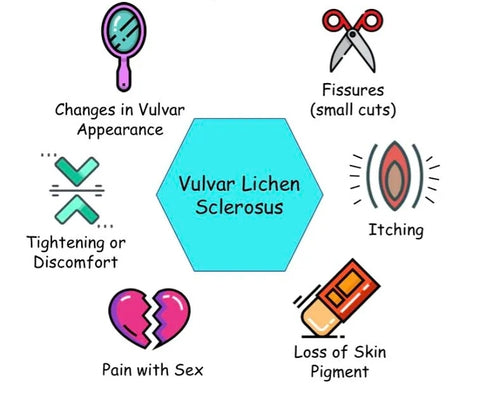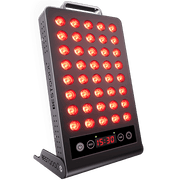What is Lichen Sclerosus?
Lichen sclerosus is a persistent, chronic inflammatory skin disease characterized by symptoms such as itching, pain, burning, and difficulty in defecation, significantly reducing the quality of life for patients.
It affects genital areas (85%) and other parts such as the inner thighs, upper limbs, neck, shoulders, chest, and intertriginous areas (15%). Lichen sclerosus can occur in women of any age and has two epidemiological peaks: prepubertal and postmenopausal, with postmenopausal women being the most common.

Causes and Symptoms of the Lichen Sclerosus
The cause and pathogenesis are currently unclear but may be related to genetics, autoimmunity, and oxidative DNA damage. Sex hormone level fluctuations, friction, trauma, infection, drugs, and radiotherapy may induce the disease.
- More than 90% of patients suffer from itching consciously, and some patients have intractable itching, which seriously affects the quality of life.
- Only erythema and edema may be present in the early stage.
- Typical rash manifests as clear-cut, thin, and shiny hypopigmented spots, such as ivory white or porcelain white, and the surface may appear moist, impregnated, or moss-like.
- Mechanical stimulation, such as slight scratching or friction, can easily cause erosion, fissures, and purpura, often accompanied by pain.
- In the late stage, structural distortion of the vulva, urethra, and anus may occur, causing difficulty in sexual intercourse, urination, and defecation.
How is Lichen Sclerosus treated?
The likelihood of spontaneous healing in lichen sclerosus is very low. In severe cases, destructive scars, sexual life disorders, and even progression to vulvar squamous cell carcinoma (SCC) may occur. Therefore, active treatment is required to control the progression of the disease. It is currently believed that early diagnosis, timely treatment, and regular follow-up can prevent damage to the vulva structure and other complications. Commonly used traditional treatments for lichen sclerosis mainly include topical corticosteroids, hormonal replacement therapy (HRT), and surgery. Long-term topical use of conventional strong glucocorticoids makes skin prone to hormone-dependent dermatitis, and the rebound effect after hormone discontinuation can lead to secondary fungal infection, human papillomavirus infection, herpes simplex virus infection, and may even increase the risk of vulvar SCC.
Red Light Phototherapy Reduces Lichen Sclerosis Symptoms
In recent years, phototherapy has emerged as a relatively new strategy to manage lichen sclerosus symptoms. Red light therapy devices are one of the types of low-level energy phototherapy that emit concentrated red and near-infrared wavelengths (660–850 nm) and stimulate our body's cellular processes with light energy (photobiomodulation). Red light therapy is safe and effective. For patients who do not respond well to traditional treatment or are unwilling to accept it, red light therapy is available as an effective alternative therapy. It is especially suitable for particular parts, such as mucous membranes in the genital, anal, and oral cavity areas.
Red light therapy has the potential advantage of soothing skin irritation and discomfort and hastening the healing process in the following ways:

Anti-inflammatory Effects
Persistent chronic inflammation of the skin makes lichen sclerosus treatment challenging. Red light therapy is well-recognized for its anti-inflammatory properties. It protects the body from free radicals and other toxic substances. It hastens the body's self-healing ability, strengthens the immune system, and directly reduces cellular oxidative stress. A study published in the Journal of Dermatological Treatment demonstrated that "red light therapy combined with the drug treatment significantly improved the vulvar lichen sclerosus-associated symptoms of pruritus, burning, and pain."
Analgesic Function
Lichen sclerosus induces continuous severe itching and erythema in patients. Red light therapy has both photochemical and thermal effects. It deeply penetrates the skin to cause blood vessel expansion and purify toxins with increased blood circulation to various tissues and organs. It triggers the release of endorphins, which act on the nervous system to reduce pain and itching. A study has shown that "red light application as a part of photodynamic therapy reduced itching, lesions, inflammatory pain, and minimized symptoms in the vulva of lichen sclerosus patients."
Improves Skin
Improving skin texture is one of the most popular uses of red light therapy. It penetrates deep into the dermis or subcutaneous tissue, activates the cells' cellular energy (ATP), and boosts collagen bioavailability. Red light enhances skin tone, anti-oxidant molecules, and is anti-aging. Skin hardening is a common side effect of lichen sclerosus; red light reduces skin roughness and wrinkles and promotes skin regeneration. The immediate application of red light therapy after skin damage can speed healing and reduce or prevent scarring. In addition, red light therapy activates stem cells, turning them into healthy skin cells. The activated stem cells stimulate nearby cells to grow into skin cells with healthy cell genes rather than scar tissue cells. Red light therapy has clinical applications for chronic skin conditions such as eczema, psoriasis, rosacea, skin ulcers, etc.
Bottom Line
Although lichen sclerosus is a less common disease, it can profoundly impact patients' physical and mental health and quality of life. Early diagnosis and intervention are essential, and if they occur, they should be actively coordinated with treatment to control and alleviate symptoms. The utility of red light therapy for lichen sclerosis healing is twofold. One is to improve patients' quality of life, symptoms, and signs, such as reducing pain associated with itching, and the other is to prevent scarring by promoting healing. By reducing inflammation and discomfort, the RLT device may support the management of this distressing dermatological condition.
References and Citations:
[1] Chamli A, Souissi A. Lichen Sclerosus. 2023 Jul 31. In: StatPearls [Internet]. Treasure Island (FL): StatPearls Publishing; 2023 Jan–. PMID: 30855834.
[2] Fistarol SK, Itin PH. Diagnosis and treatment of lichen sclerosus: an update. Am J Clin Dermatol. 2013 Feb;14(1):27-47. doi: 10.1007/s40257-012-0006-4. PMID: 23329078; PMCID: PMC3691475.
[3] Declercq A, Güvenç C, De Haes P. Proposal of a standardized protocol for photodynamic therapy for vulvar lichen sclerosus. J Dermatolog Treat. 2022 Feb;33(1):560-568. doi: 10.1080/09546634.2020.1771260. Epub 2020 Jun 1. PMID: 32420789.
[4] Osiecka BJ, Nockowski P, Jurczyszyn K, Ziólkowski P. Photodynamic therapy of vulvar lichen sclerosus et atrophicus in a woman with hypothyreosis--case report. Photodiagnosis Photodyn Ther. 2012 Jun;9(2):186-8. doi: 10.1016/j.pdpdt.2012.02.002. Epub 2012 Mar 27. PMID: 22594990.
[5] Gerkowicz A, Szczepanik-Kułak P, Krasowska D. Photodynamic Therapy in the Treatment of Vulvar Lichen Sclerosus: A Systematic Review of the Literature. J Clin Med. 2021 Nov 23;10(23):5491. doi: 10.3390/jcm10235491. PMID: 34884193; PMCID: PMC8658411.













 Small
Small

 Moderate
Moderate

 Moderate
Moderate

 Moderate
Moderate

 Full
Full



